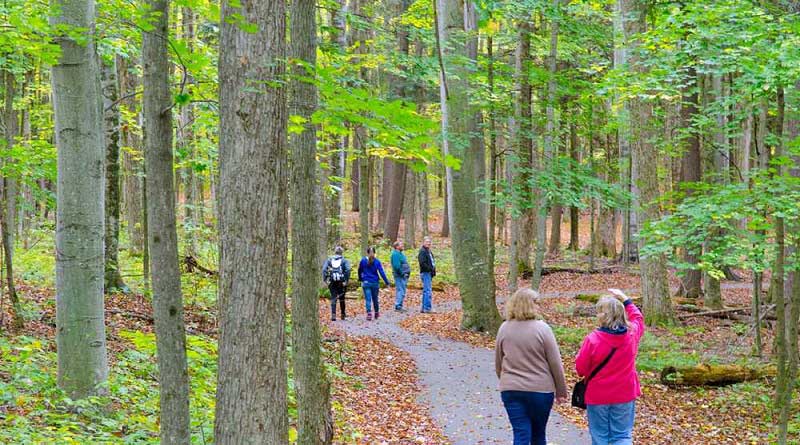Recognizing Michigan’s State Symbols
On March 4, 1955 (65 years ago), the eastern white pine tree (Pinus Strobus, also known as a “soft pine”) was adopted as the official State Tree of Michigan. This conifer tree can be found in almost every county of the Upper and Lower Peninsula, typically growing in mixed forests and sandy plains.
Did you know?
- Hartwick Pines State Park (Crawford County, near Grayling) is a 9,762-acre state park – the largest state park in the Lower Peninsula and the fifth largest in the entire state. The park contains a 49-acre parcel of old-growth forest of white pines that was spared during logging of the early 1900s by being donated to the state by one of the heirs of the logging company’s original owners, Karen Michelson Hartwick (the original tract of pines was 85 acres). An additional 8,000 acres of cut land was also donated as a memorial to the logging industry and in the 1930s, the Civilian Conservation Corp built the Hartwick Pines Logging Museum adjacent to the protected grove. The museum boasts two replica logging camp buildings, outdoor exhibits of logging equipment and an enclosed steam-powered sawmill that is operated during summer months.
- Sylvania Wilderness encompasses 18,327 acres of wild terrain within the nearly one-million-acre Ottawa National Forest in the western Upper Peninsula (near Watersmeet, Gogebic County). Within this tract of land, record-sized white (and red) pines as well as old-growth hardwoods still stand.
- The 92-mile Fred Meijer White Pine Trail State Park runs from Comstock Park in Kent County to Cadillac in Wexford County. The trail is surfaced with asphalt pavement, with a 30-mile section between Sand Lake and Big Rapids which is natural ballast and hard-packed gravel. It is operated under the Michigan Department of Natural Resources and promoted by the Friends of the White Pine Trail.
- According to the Michigan Big Tree Program, the largest white pine in Michigan is a 143-foot Eastern White Pine in Luce County (2007).
- Michigan In Pictures shares the following information about white pines:
- It was called the Tree of Peace by the Iroquois.
- Mature white pines can easily live 200+ years of age, with some Michigan trees that have approached 500 years in age.
- The eastern white pine has the distinction of being the tallest tree in eastern North America, and pre-colonial stands were reported over 200 feet in height.
- It was said that when settlers arrived, a squirrel could travel in the forest canopy from one side of the state to the other.
- Michigan led the nation in lumber production in the 1880s and 1890s, and by the early 1900s, over 100 million of Michigan pine trees worth more than all the gold mined in California had been felled in the Lower Peninsula. Most of that value was in white pine, and when the forest was depleted, timber companies moved to the UP.
- Small white pines are popular as Christmas trees due to their ability to hold needles.
- Large white pines were prized as ship masts and known as mast pines by the British navy. These trees were marked with a broad arrow by agents of the crown, a very controversial action that was one of the factors leading to the Revolutionary War. The original masts on the USS Constitution(aka Old Ironsides) were single trees before they realized that laminated trees were better about to withstand cannon fire.
While we’re at it…let’s take a quick look at Michigan’s other state symbols and when they were first recognized:
- In 1897, the APPLE BLOSSOM (Pyrus coronaria) was designated the state flower. Sponsors noted it was “one of the most fragrant and beautiful flowered species of apple.” It is native to the state.
- In 1931, the AMERICAN ROBIN (Turdus migratorius) was chosen the state bird. It had been favored by the Michigan Audubon Society. Sponsors called the robin “the bestknown and best-loved of all the birds in the state of Michigan.”
- In 1965, the PETOSKEY STONE (Hexagonaria pericarnata) was adopted as the state stone. The Petoskey stone is fossilized coral that existed in the northern Lower Peninsula about 350 million years ago.
- In 1965, the TROUT was designated as the state fish. In 1988, the Michigan legislature specified the BROOK TROUT (Salvelinus fontinalis) as the state fish. The brook trout is native to Michigan and found throughout the state.
- In 1972, CHLORASTROLITE (literally “green star stone”) was adopted as the state gem. Known as the Isle Royale greenstone, Chlorastrolite ranges in color from yellowgreen to almost black. It is primarily found in the Upper Peninsula.
- In 1990, KALKASKA SAND was chosen as the state soil. First identified as a soil type in 1927, Kalkaska sand ranges in color from black to yellowish brown. It is one of more than 500 soils found in the state. Unique to Michigan, Kalkaska sand covers nearly a million acres in 29 Upper and Lower Peninsula counties.
- In 1995, the PAINTED TURTLE (Chysemys picta) was chosen as the state reptile after a group of Niles fifth graders discovered that Michigan did not have a state reptile.
- In 1997, the WHITE-TAILED DEER (Odocoileus virginianus) was designated the state game mammal after the successful lobbying efforts of a group of Zeeland fourth graders. Found in every Michigan county, the white-tailed deer is an important natural and economic resource.
- In 1998, the DWARF LAKE IRIS (Iris lacustris) was designated as the state wildflower. Native to the state, the endangered flower grows along the northern shorelines of Lakes Michigan and Huron.
- In 2002, the MASTODON (Mammut americanum) became the state fossil. Fossils of the prehistoric mammal have been found in more than 250 locations in the state.
Source: Michigan State Symbols. Photo: Pure Michigan.

